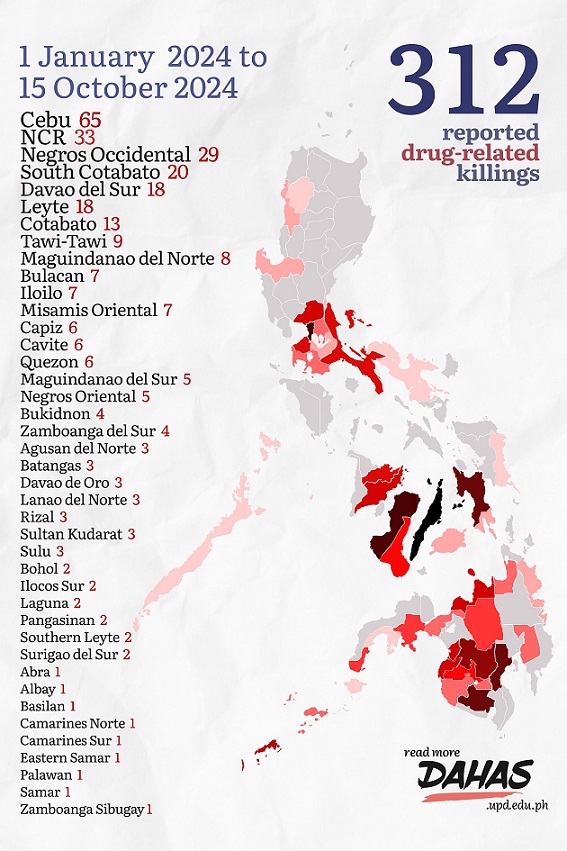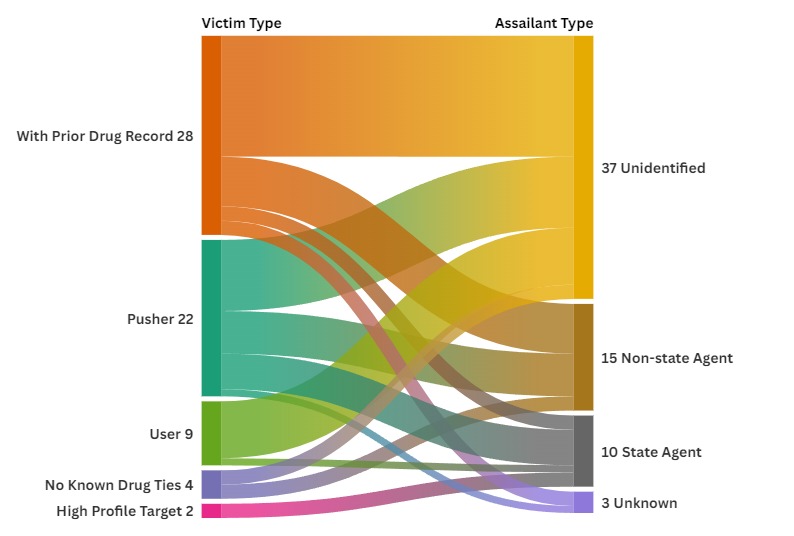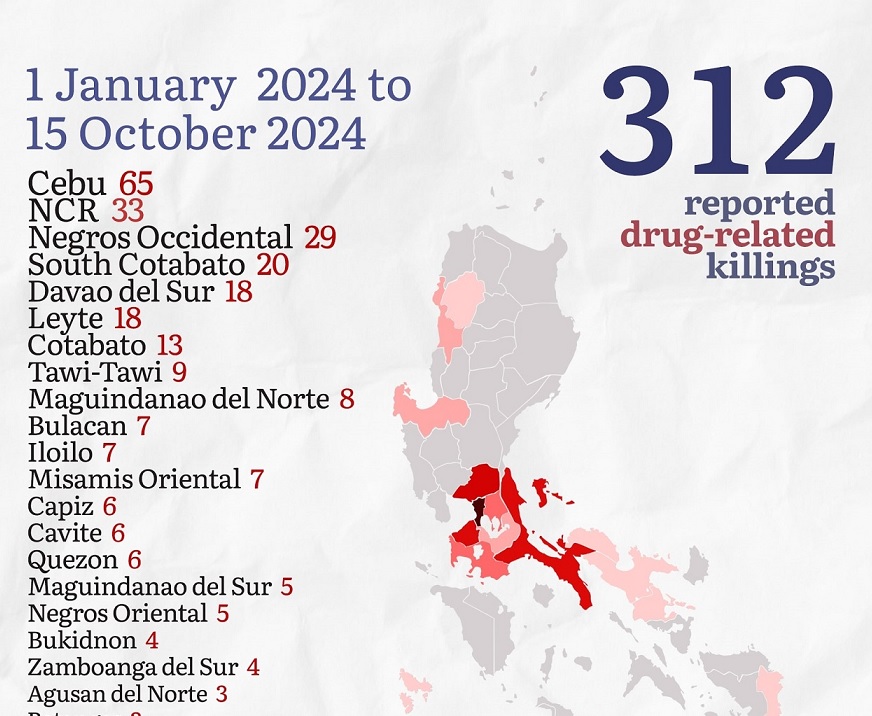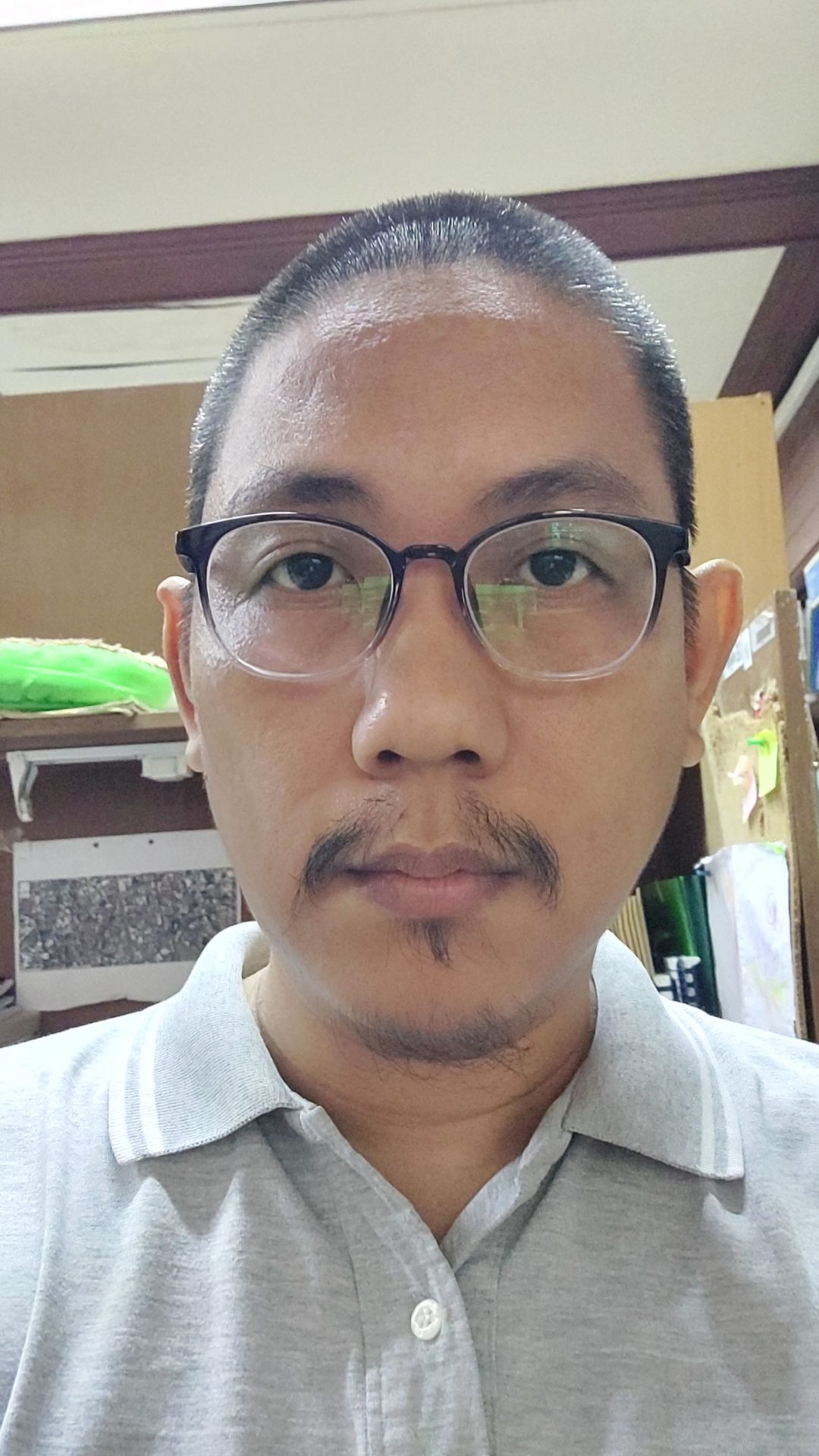Cebu, with 65 killings from January until October 15, is currently the top hotspot in the Philippines for reported drug-related killings dislodging Davao del Sur which was the topnotcher the past two years.
This is based on the monitoring by the Dahas Project of the Third World Studies Center, College of Social Sciences and Philosophy, University of the Philippines Diliman.
Cebu edging out Davao City as number one in drug-related killings in the country may have less to do with the Cebuano’s proclivity for murder than with the shifting political fortunes of the Dutertes.
On March 22, Davao City Mayor Sebastian “Baste” Duterte declared his own war on drugs, in open defiance of the Marcos administration’s oxymoronic “bloodless war on drugs,” a denunciation of former president Rodrigo Duterte’s bloody war on drugs.
Within six days, seven drug-related killings were reported in Davao City.
It was just a leveling up of Baste’s “Kill” strategy against illegal drugs. Three months prior to his March declaration, there were already 10 drug-related killings in Davao City, nine of those attributed to the police. Prior to this period, since Baste took office on July 1, 2022 until December 31, 2023, there have been 87 drug-related killings in Davao City.
Effect of breakup of 2022 Duterte-Marcos alliance
Baste’s violently aggressive war on drugs, however, got stymied by the unraveling of the 2022 political marriage of convenience between the Marcoses and the Dutertes. The head of the Davao City police was replaced several times over, cops suspected of being involved in the killings were taken out of their posts (at first 8, then eventually 35), and the Commission on Human Rights launched an investigation.
For 5 months and 21 days (March 27 to Sept. 16), Davao City or even in the whole of Davao del Sur, posted a record of no drug-related killings broken only by the killing by the police of a drug pusher in a buy-bust operation on Sept. 17.
From then until Oct. 15, there were no recorded drug-related killings in Davao del Sur again.
When is killing considered drug-related?
For the Dahas Project, a killing is drug-related if the victim “was killed in a drug-related operation, activity, or encounter; was reported to be involved in the drug trade or in the war on drugs in whatever capacity (e.g. alleged drug personality, law enforcer, informant, etc.); was reported to be in possession of illegal drugs at the time of the killing or when the body was found; was reported to be associated with someone involved in the drug trade; and was killed by someone reported to be involved in the drug trade for drug-related reasons” The Dahas Project draws its data “from news accounts online posted by various media organizations in the country and occasionally from social media posts of police units and other state actors.”
The Dahas Project’s national total for reported drug-related killings from January to October 15, is 312. Cebu accounts for 21 percent—1 in every five—of the reported killings at a rate of almost two (1.59) killings in a 41-week period.

This is a marked difference from the average rate of killings in Davao del Sur (mainly in Davao City), the top hotspot since 2022 or the start of the Marcos administration, which was one killing a week. These killings, except for a case or two, were committed in general by the Davao City police.
Cebu’s share in the national total also surpasses the record of Davao City in the last two years, which did not exceed 16 percent.
Cebu’s number is double that of the two other areas that follows it, the National Capital Region (33) and Negros Occidental (29) and more than triple of the provinces in the third tier like Leyte (18), Davao del Sur (18), and South Cotabato (20).
Mostly young victims
Most of those killed in Cebu were male (56) rather than female (9) and they were in the age range that spans 20-49 years old.
Most of those killed in Cebu were male (56) rather than female (9) and they were in the age range that spans 20-49 years old.
| Table 1. Age and Sex of the Fatalities in Reported Drug-Related Killings in Cebu, January-October 15, 2024 | ||
| Age Group | Sex | |
| Male | Female | |
| Younger than 13 | 0 | 0 |
| 13-19 | 3 | 0 |
| 20-29 | 14 | 2 |
| 30-39 | 16 | 2 |
| 40-49 | 13 | 3 |
| 50-59 | 2 | 0 |
| 60-69 | 1 | 0 |
| Unreported | 7 | 2 |
| Total | 56 | 9 |
The youngest victim was a 17-year-old male, shot in the head while riding his electric bike on May 1 at Barangay Sambag 1, Cebu City. The oldest was a 67-year-old male who was previously imprisoned on drug charges and once out of jail returned to dealing drugs. He was shot in the early morning hours of August 2 while sleeping inside his house at Barangay Mambaling, Cebu City.
| Table 2. Reported Drug-Related Killings in Cebu by City or Municipality, January-October 15, 2024 | |
| Municipality/City | Number of Killings |
| Cebu City | 38 |
| Talisay | 4 |
| Toledo | 3 |
| Argao | 2 |
| Balamban | 2 |
| Consolacion | 2 |
| Lapu-Lapu City | 2 |
| Mandaue City | 2 |
| Aloguinsan | 1 |
| Carcar | 1 |
| Compostela | 1 |
| Cordova | 1 |
| Dalaguete | 1 |
| Liloan | 1 |
| Medellin | 1 |
| Minglanilla | 1 |
| Moalboal | 1 |
| Ronda | 1 |
| Total | 65 |
Of Cebu’s 53 local government units, drug-related killings have been reported in 18. The drug-related killings in Cebu are concentrated in Cebu City, which accounts for 58.46% (38 of the 65) of all the killings.
| Table 3. Reported Drug-Related Killings in Cebu City by Barangay, January-October 15, 2024 | |
| Barangay | Number of Killings |
| Mambaling | 10 |
| Duljo Fatima | 4 |
| Guadalupe | 3 |
| Suba | 2 |
| Tejero (Villa Gonzalo) | 2 |
| Tisa | 2 |
| Basak San Nicolas | 1 |
| Buhisan | 1 |
| Bulacao | 1 |
| Calamba | 1 |
| Cogon Pardo | 1 |
| Day-as | 1 |
| Ermita | 1 |
| Kalunasan | 1 |
| Pahina San Nicolas | 1 |
| Pasil | 1 |
| Poblacion Pardo | 1 |
| Punta Princesa | 1 |
| Sambag I | 1 |
| Sambag II | 1 |
| San Roque | 1 |
| Total | 38 |
The 38 killings in Cebu City are in turn spread over 21 of its 80 barangays. A significant concentration can be found in two barangays that are next to each other. There were 10 killings in Mambaling and another 4 in Duljo Fatima. Most of the killings are in coastal barangays fronting the Mactan Channel.
Besides having a fifth of the national total in the reported drug-related killings, the profile of the victims and assailants in Cebu points to particular dynamics that are unique to the province. (For the definition of these categories, see the “Preface” of the Dahas Project report, Drug-Related Killings in the Marcos Administration, Year 2.)
| Table 4. Comparing Cebu to the National Tally of Victims of Reported Drug-Related Killings, January 1-October 15, 2024 | ||||
| Type of Victim | National | Percentage (%) | Cebu | Percentage (%) |
| High-Profile Target | 29 | 9.29 | 2 | 3.08 |
| Pusher | 103 | 33.01 | 22 | 33.85 |
| User | 53 | 16.99 | 9 | 13.85 |
| With Prior Drug Record | 108 | 34.62 | 28 | 43.08 |
| No Known Drug Ties | 19 | 6.09 | 4 | 6.15 |
| Total | 312 | 100 | 65 | 100 |
In the national tally, those characterized as pushers and those with prior drug records are the main victims in the killings. Their combined shared percentage is 67.63; Cebu is at 76.93. This difference, percentage-wise, is due to Cebu having more victims with prior drug records.
In the national tally, those characterized as pushers and those with prior drug records are the main victims in the killings. Their combined shared percentage is 67.63; Cebu is at 76.93. This difference, percentage-wise, is due to Cebu having more victims with prior drug records.
In the nine-and-a-half-month period covered by the Dahas Project, there were only two high-profile targets killed in Cebu. The first one was killed in Barangay Tangke in Talisay City on March 11 and the second one in Barangay Bulacao, Cebu City on May 23. These two killings are 3.08 percent of the total. In the national tally, killings of high-profile targets are at 9.35 percent.
Killed with no known drug ties
The category where Cebu and the national tally is similar is those killed with no known drug ties. As defined by the Dahas Project, those listed under “no known drug ties” were those who were “killed during a drug-related operation, encounter between private individuals, or vigilante
assault but is not reportedly involved in the drug trade or the drug war in any capacity. This usually includes passersby or individuals associated with targeted drug suspects (e.g. kin, employees, neighbors). They can also be law enforcers who were killed in drug-related law enforcement operations. This category also includes cases of mistaken identity, where the victim was killed because he or she was believed to be involved, erroneously or without sufficient evidence, in the drug trade or the drug war in any capacity.”
In Cebu, of the four killed and categorized as having no known drug ties, three of them were alleged to be police informants and the fourth one a case of mistaken identity. On March 9, a 16-year-old hired gunman shot to death a 23-year-old woman while sleeping inside her room in Barangay Suba, Cebu City. She was suspected by those in the drug trade as being a police informant. Another alleged police informant who caused the arrest of drug pushers was also shot to death while on the road driving his motorcycle in Toledo, Cebu last August 1. A newcomer in Barangay Mambaling in Cebu City who was looking for a job was suspected by the local drug players in the area as being a police informant. He was shot to death by a known hitman on August 30. Earlier, on August 8, a 23-year-old man was shot to death, also in Barangay Mambaling, Cebu City. It was assumed to be a case of mistaken identity. He resembled a well-known drug addict in the area.
| Table 5. Comparing Cebu to the National Tally of Assailants in Reported Drug-Related Killings, January 1-October 15, 2024 | ||||
| Type of Assailant | National | Percentage (%) | Cebu | Percentage (%) |
| State Agent | 103 | 33.01 | 10 | 15.38 |
| Non-state Agent | 59 | 18.91 | 15 | 23.08 |
| Unidentified | 123 | 39.42 | 37 | 56.92 |
| Unknown | 27 | 8.65 | 3 | 4.62 |
| Total | 312 | 100 | 65 | 100 |
Assailants in Cebu are mostly unidentified (there were witnesses or audiovisual recording of the killing, usually via CCTV or closed-circuit television, but no proper identification of the assailant was made). The national tally attributes 39.42 percent of reported drug-related killings to unidentified assailants, much less than Cebu’s 56.92 percent (a difference of 17.5 percent).
Hired killers
Of those who were identified, characterized as non-state agents in the Dahas Project monitor, many were tagged in the news reports as hired killers. After arrest, a few even confessed to their murderous vocation. This is a trend in Cebu that the Dahas Project has noted in an earlier report.
In recent news accounts a new feature emerges, some of them started killing for a fee while they were still in their teens. One 18-year-old hired gun started making money out of killing people when he was 14-years old. He was caught in a drug buy-bust operation in Barangay Sambag II in Cebu City on June 11, 2024. Another hitman, 19 years old, had already killed 8 persons in a two-month period. He was also arrested in a drug buy-bust operation in Barangay Mambaling, Cebu City on September 2, 2024.
Some of the arrested hired killers have previously served time in jail, either for arms or drug charges. Once out, they become “an alleged hitman for a drug personality.” When a dealer fails to remit the expected proceeds from a drug deal, a hired gun is called upon for the kill.
The average fee for a contract hit is PHP 25,000 to PHP 30,000.00.
In Cebu, the police and other state actors account for a much lesser share of the killings (15.38 percent). State agents in the national tally account for 33.01 percent of the killings, often in drug buy-bust operations.
There are only three cases of reported drug-related killings in Cebu caused by unknown assailants. The first two cases have no witnesses and the third one a case of a body dump.

Of the 28 victims with prior drug records, 17 were killed by unidentified assailants, 7 were by non-state agents, 2 by state agents, and 2 by unknown killers. Of the 22 pushers killed, 10 were killed by unidentified assailants, 6 were by non-state agents, 5 by state agents, and 1 by an unknown assassin. Of the 9 pushers killed, 8 were killed by unidentified assailants and only 1 by a state agent. Of the 4 killed with no known drug ties, 2 were killed by unidentified assailants and 2 by non-state agents. Both cases of high-profile target killings were committed by state agents.
These numbers render the possibility that in Cebu, more than in any other place in the country, those who were previously involved in the drug trade, despite having been known or even convicted of such illegal acts, may have continued to do so even at great peril to themselves. This is not sheer addiction but a calculated exposure to risk for financial gain. The presence of a number of hired killers who are also dealing drugs after serving time in prison supports the assumption that there is a resilient and more lethal network of drug trade players in Cebu.
The concentration of the drug-related killings in particular localities—Cebu City as the provincial killing hub and Mambaling as Cebu City’s barangay of drug butchers—indicates that these places of impunity are somewhat impervious to external and countervailing forces.
The prevalence of unidentified assailants in drug-related killings in Cebu for almost an entire year now is an indictment of the police’s seeming inability to contain, if not entirely put an end to this kind of killings.
If the Marcos administration can almost put an end to drug-related killings in Davao City, why can’t it in Cebu?
(Joel F. Ariate Jr. is a university researcher at the Third World Studies Center, College of Social Sciences and Philosophy, University of the Philippines Diliman. He oversees the Dahas Project. Follow the weekly and monthly numbers of the Dahas Project at https://twitter.com/DahasPH. Vincent Halog and Madeleine Ibe provided research assistance for this report.)






